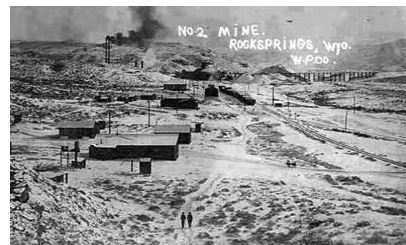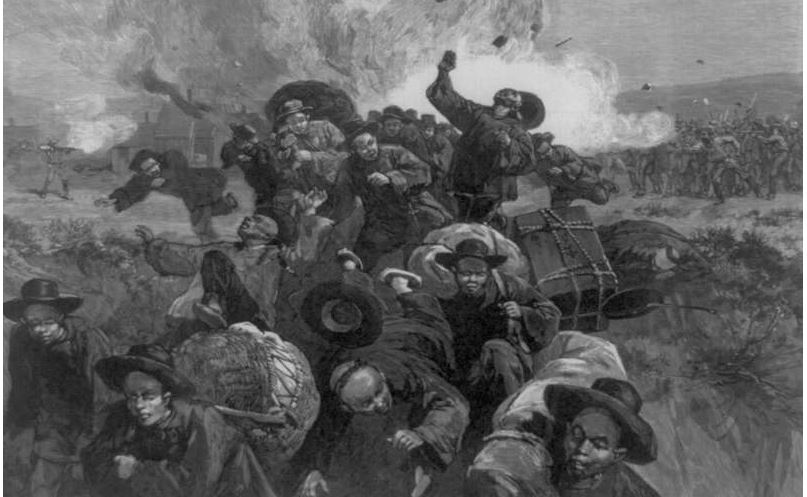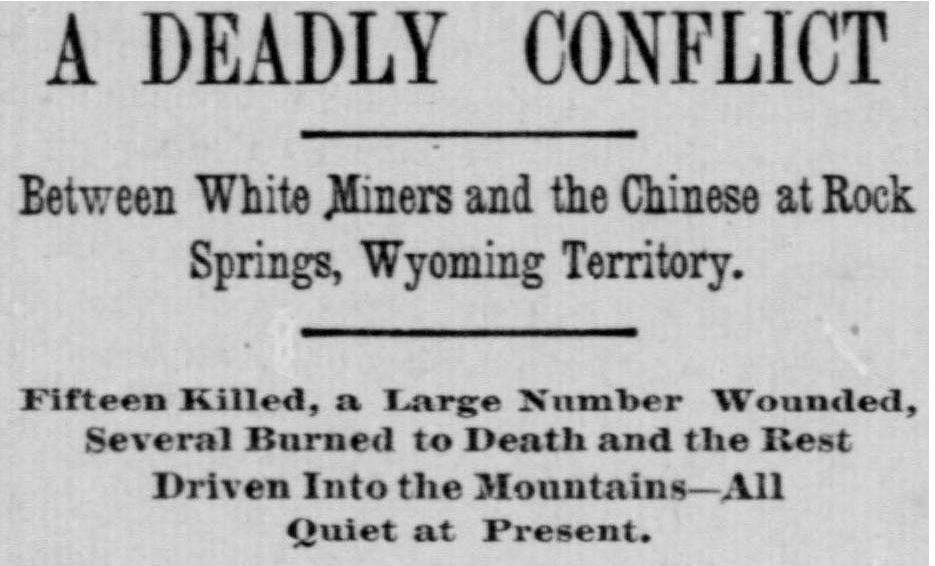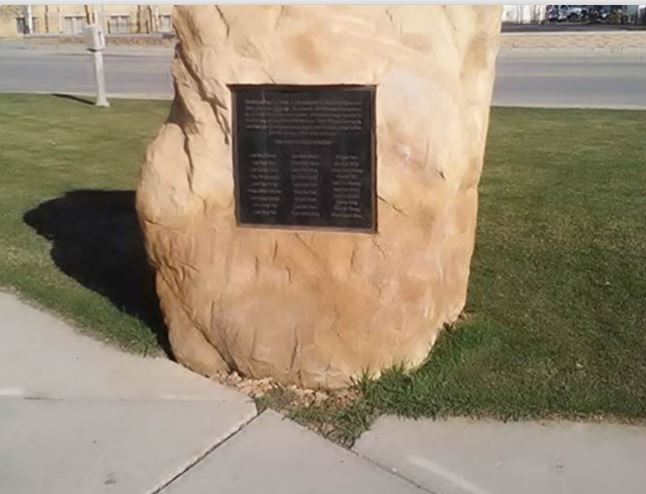By Raymond Douglas Chong, AsAmNews Staff Writer
In Rock Springs, Wyoming, a large rock with a bronze plaque marks a memorial to a horrific incident, along Bitter Creek. It reads”
On September 2, 1885, a riot occurred in Rock Springs over
labor and race disputes. As a result, 28 Chinese miners were
killed and Chinatown was razed. Chinatown was located in
front of you across Pilot Butte Avenue. The Chinese eventually
returned and no one was prosecuted for the murders. Listed below
are the names of the fallen Chinese.
WE HONOR YOUR MEMORY
Background
Along the Great Basin Divide, the immense Rock Springs coalfield fueled the steam locomotives of the Union Pacific Railroad Company. Gangs of White immigrants labored in coal mines.

In 1875, they went on strike for higher wages. The Union Pacific Coal Department soon hired Chinese laborers to replace them as strikebreakers. The Chinese were segregated in camps of Chinatown, along Bitter Creek, separate from “White Men’s Town.” The racial hatred constantly simmered between them.
After the Congressional passage of the Chinese Exclusion Act of 1882, anti-Chinese sentiment swept across the wildlands of the American West. Whites expelled Chinese from Chinatowns. The Knights of Labor, a union against Chinese immigrant labor, formed a chapter in Rock Springs in 1883.
On September 2, 1885, White coal miners rioted inside the coal mines. The White mob brutally clubbed, shot, and burned the Chinese. The survivors frantically fled beyond Bitter Creek toward Evanston.
Killings started at coal mine first, then spread into town. Railroad workers joined the mob of coal miners for the slaughter at Chinatown.
“The attacks at Rock Springs were extraordinarily violent, revealing a long-held hatred of the victims,” according to David T Courtwright in his book from Harvard University Press, Violent Land: Single Men and the Social Disorder from the Frontier to the Inner City . “Besides those who were burned alive, Chinese miners were scalped, mutilated, branded, decapitated, dismembered, and hanged from gutter spouts. One of the Chinese miners’ penis and testicles were cut off and toasted in a nearby saloon as a “trophy of the hunt.” The events amounted to racial terrorism.”

When the riot ended, 28 Chinese miners were dead and 15 were injured. The White mob burned the entire Chinatown with its 79 camp homes.
The survivors reported later to a Chinese consul in New York City, “Mangled and decomposed, the bodies were being eaten by dogs and hogs.” An official investigation indicated: four bodies found mutilated; nine bodies found burned; and fifteen bone fragments only or no bodies found.
In the riot aftermath, Francis Warren, the Wyoming Territory Governor urgently responded, on behalf of Union Pacific Coal Company. United States Army soldiers were deployed in Rock Springs. They escorted the surviving Chinese coal miners in Union Pacific Railroad Company boxcars from Evanston to Rock Springs. At Camp Pilot Butte, Army soldiers protected the Chinese coal miners, until the onset of the Spanish American War in 1898.
Joseph Young, Sweetwater County Sheriff, arrested sixteen White men, charged with riot, arson, murder, and robbery. They were jailed at the County Jail at Green River. A Sweetwater County grand jury declared no cause for indictments, “We have diligently inquired into the occurrence at Rock Springs. … Though we have examined a large number of witnesses, no one has been able to testify to a single criminal act committed by any known White person that day.”
From San Francisco and New York City, the Chinese consuls of Imperial Cathay investigated the Rock Springs Massacre. They drew up a list of property damages. President Grover Cleveland pressured Congress to provide $147,748.74 as an indemnity.
Wyoming State History
Tom Rea wrote The Rock Springs Massacre article for the encyclopedia of the Wyoming State Historical Society.
He said: “White miners and their families, most of them recent immigrants from Europe, almost certainly felt the Chinese miners, willing to work for lower wages, were keeping White miners’ wages low as well. And with company officials having been instructed the year before to hire only Chinese miners from then on, the White miners would feel their jobs and their livelihoods were under a more direct threat than ever. There would have been a lot of racism mixed in with their feelings as well. A whole lot.”
“Do not know if the union did so in any formal way. It does seem likely though that when after the killing of the first Chinese man the first morning, when White miners went home, armed themselves. And then met in the Knights of Labor hall before moving to the saloons, they were steadily, murderously talking themselves into taking violent action.” Tom Rea said.

Tom Rea mentioned the major role of Francis Warren, the Wyoming Territory Governor. He protected lives of the Chinese coal miners. He protected the interests of the Union Pacific Coal Department. “Both, pretty clearly. He deserves credit for the first. The second is consistent with his actions through his long political career that followed. He steadily served corporate interests all that time, the Union Pacific Coal Department always top among them. And remember, it was in the company’s interest to preserve the lives of the Chinese miners, too.”
He speculated about the injustice: “Hard to say, but this is common in mob actions of the time. Witnesses were probably afraid to testify, sympathized with the White miners, or both.” On the legacy of the Rock Springs Massacre, Tom Rea mused: “Also hard to say. I suspect most people do not know much about it. People who do know about it shake their heads in sorrow when the topic comes up.”
Incident at Bitter Creek – The Book
Craig Storti wrote the book Incident at Bitter Creek – The Story of the Rock Springs Chinese Massacre. The White coal miners fought with the Union Pacific Coal Department. From the Celestial Kingdom, the Chinese coal miners were racial victims in a bitter labor dispute.
RAYMOND DOUGLAS CHONG: What was the catalyst for you to write “Incident at Bitter Creek”?
CRAIG STORTI: The catalyst was that I visited my brother every summer where he lived in Rock Springs. I was just starting out as a writer, just newspaper articles by then, and thought I should write a book. I did not have any particular interest in the Chinese in America; I just wanted to write a book and found a good story.
RAYMOND DOUGLAS CHONG: What was the importance of Rock Springs?
CRAIG STORTI: The importance was that the Massacre touched off a wave of anti-Chinese sentiment throughout the West, leading to tough new restrictions on hiring Chinese and on allowing new Chinese to come to the United States. It also led to increased anti-Chinese sentiment throughout the United States and led to the end of the Union Pacific Coal Department hiring Chinese to replace Whites.
RAYMOND DOUGLAS CHONG: Why was the anti-Chinese sentiment of the Whites so prevalent at the coal mines at Rock Springs?
CRAIG STORTI: The Union Pacific Coal Department was using the Chinese to drive the White miners out or make them work for very low wages. Basically the Union Pacific Coal Department was using the Chinese to destroy the labor union. Even from today’s perspective, the treatment of the Whites seems unfair and the Chinese were the only reason the Union Pacific Coal Department could force the miners to leave. So naturally the miners resented being treated badly, and they saw the Chinese as being responsible for that treatment. It was mainly the Union Pacific Coal Department that was at fault, of course, but the Chinese were not entirely innocent; they knew they were the reason Whites could be treated so badly, but they expected the company to protect them.

RAYMOND DOUGLAS CHONG: Did the Knights of Labor, the union, encourage the Massacre?
CRAIG STORTI: No they did not. Nor would it have been a very wise move; it would have given the labor union a very bad name. The Massacre appears to have been spontaneous, not planned, although it was coordinated in the sense that the mob members were working together and cooperating. I do not think any of them expected it to turn into a Massacre. Emotions, which had been running high, took over and things quickly got out of hand. Of course there was simmering resentment against the Chinese and the union was looking for any chance to drive them away. But there is no evidence the Massacre was planned. The situation quickly escalated; I suspect that after the fact at least some of the miners, but clearly not all, were as appalled at the loss of life as everyone else was. If they could have driven the Chinese out some other way, they would have been happy. And remember they did send a message to the Chinese that they should pack up and leave, but the Chinese expected the Union Pacific Coal Department to protect them.
RAYMOND DOUGLAS CHONG: Why did Governor Francis Warren intervene? To protect lives of the Chinese coal miners? Or to protect interests of Union Pacific Coal Department?
CRAIG STORTI: I think Warren intervened primarily to restore order in what had become a very lawless, dangerous situation. I believe he probably supported the Union Pacific Coal Department over the miners, but I am sure he was as appalled as everyone else at the loss of life. He was not pro-Chinese.
RAYMOND DOUGLAS CHONG: Despite many witnesses, why did grand jury refuse to indict the killers?
CRAIG STORTI: To begin with the Chinese were not allowed to testify at the trial, so their side of the events was never told. And everyone who did testify was either on the side of the miners, against the railroad and also against the Chinese, or just afraid to say anything bad about the miners.
RAYMOND DOUGLAS CHONG: Despite their fears of more attacks, why did the Chinese coal miners stay after the Massacre?
CRAIG STORTI: They stayed because for 13 years there were Federal troops stationed in Rock Springs specifically to protect them.
RAYMOND DOUGLAS CHONG: What is the legacy of Rock Springs Massacre for people of Wyoming?
CRAIG STORTI: Most people in Wyoming do not know about the Massacre. I am not sure it is even taught in high school history classes in Wyoming. The immediate legacy is that the Union Pacific Coal Department stopped bringing in Chinese miners, but that did not help the White miners that much because the Union Pacific Coal Department started using machines for some jobs.
A Bitter Retrospection
Jennifer Messer, Museum Coordinator, Rock Springs Historical Museum, with a unique vantage, offers her bitter retrospection:
“I struggle with the idea that any community could reconcile itself with an event as ugly and brutal as the Chinese Massacre of 1885. Twenty-eight men were killed, while an unknown number more simply disappeared. There were no substantial punishments handed out to the individuals, business or political entities involved. And no clear mark of closure to the events of that September for the community.”
“Rock Springs has done what other communities faced with an enormous tragedy have done. Over the past 135 years, the community has blamed others for the events of that day, ignored that it happened, incorporated it into the story of the City, both positively and negatively. The community has used it as a teaching opportunity in our local schools and erected several monuments in honor of those who were killed here. Often, we have managed to do several of these at the same time.”
“We need to continue teaching the history of the Rock Springs Chinese Massacre in schools, offer thoughtful historical exhibits in our Museums, mark the date of the Massacre every year, and maintain memorials to those men who were killed in our public spaces,” said Messer.
AsAmNews has Asian America in its heart. We’re an all-volunteer effort of dedicated staff and interns. Check out our new Instagram account. Go to our Twitter feed and Facebook page for more content. Please consider interning, joining our staff, or submitting a story.



Wow. First time hearing about this one. It must have been quite a wild area with no one around except for the miners – White and Chinese. In such an isolated area, I can see how things could get out of hand very quickly.